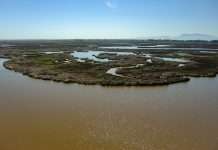Ongoing discussions on improving conditions in the Sacramento-San Joaquin Delta, central to water access and supply considerations in California, inched ahead this month.
The focus was on the voluntary water agreements process as Governor Gavin Newsom penned a commentary highlighting the agreements the same day as two state agencies released a framework for voluntary agreements to improve habitat and flow in the Delta and key watersheds.
The Governor wrote that the framework “will provide the foundation for binding voluntary agreements between government agencies and water users with partnership and oversight from environmental groups.”
In the news release announcing the framework, California Natural Resources Secretary Wade Crowfoot said the framework is “an important milestone, but there is much work ahead to shape it into a legally enforceable program.”
Framework
The State Water Resources Control Board is obligated by federal and state water law to protect beneficial uses, including fish and wildlife, in the Bay-Delta watershed.
The voluntary agreements framework is outlined in a fact sheet and PowerPoint on the California Natural Resources Agency website:
• The 15-year program aims to “improve environmental conditions, in an adaptive way.”
• The framework generates more than $5 billion in new funding for environmental improvements and science, with $2.34 billion (44%) coming from water users, $2.22 billion (42%) from state government, and $740 million (14%) from the federal government.
• More than 60,000 acres of new and restored habitat will be created, ranging from targeted improvements in tributaries to “large landscape-level restoration” in the Sacramento Valley.
• Up to 900,000 acre-feet of new water flows is to be provided for the environment above existing conditions in dry, below normal and above-normal water years, and several hundred acre-feet in critical and wet years to help recover fish populations.
• A key goal is to double the California salmon populations by 2050.
• Projected allocations of the new funding include $285 million (5%) for a “collaborative science” program to augment existing monitoring; $456 million (9%) for voluntary paid fallowing of land; $1.204 billion (23%) for water purchases; $1.632 billion (31%) for new water projects and programs; and $1.684 billion (32%) to expand and improve habitat.
What’s Next
The Resources Agency and the California Environmental Protection Agency (Cal/EPA) will be working with water users and other participants “in coming weeks and months” to refine the framework into a legally enforceable program, according to the news release.
The refined framework will serve as the basis for developing legally enforceable voluntary agreements that will go through a third-party scientific review, environmental review and public approval process at the State Water Board.
Agreements approved by the State Water Board could be implemented right away, according to the fact sheet.
CalChamber Position
The California Chamber of Commerce supports the voluntary agreements process as a viable means of meeting environmental objectives of the Bay-Delta Water Quality Control Plan.
Stakeholders are working with regulators and environmentalists to improve conditions for fish and wildlife on the San Joaquin River and its tributaries. They are voluntarily reducing their water draw at certain times of the year, modifying some business practices to use less water, and contributing to conservation habitats in the Delta.
A voluntary process to achieve environmental goals is preferable to mandatory restrictions.


